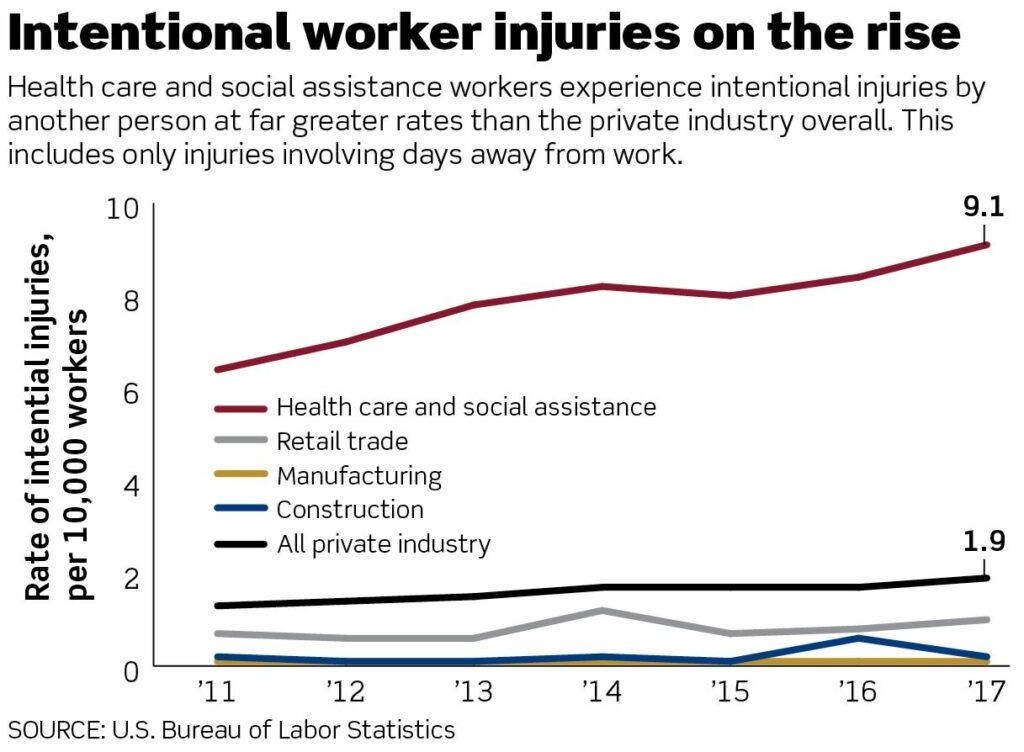Hospitals play a critical role in preparing for and responding to epidemics and other health emergencies. Recently, they’ve been on the frontlines battling a different type of epidemic– the rising occurrence of workplace violence.
The recent tragedy of a Wisconsin nurse found frozen to the ground under her vehicle after being brutally attacked in a hospital parking garage and an active shooter incident at a Chicago hospital claiming four lives are just two examples of fatalities that occurred this year.
The Bureau of Labor Statistics recently reported that workplace violence incidents are reported by health care workers and social assistance workers at far greater rates than the private industry overall. According to the Bureau, “health care and social service workers” suffered 69 percent of all workplace violence injuries caused by persons in 2016” and “these rates increased by 63 percent between 2006 and 2016.”

Workplace violence in health care and human services industries accounts for nearly as many serious violent injuries as all other industries combined. Workers in these fields are more than four times as likely to be attacked or assaulted on the job, or become victims of workplace violence, than any other industry.
This may be attributed to a higher likelihood of working with people who may have a history of violence, are delirious, or under the influence of drugs. For each worker, the risk factors often depend on the type and location of the health care services being provided. Risk factors include, but are not limited to, transporting patients and clients, working alone in patient’s homes, poorly lit corridors, rooms, and parking lots, high work turnover, and lack of facility policies. Without the proper training and protection, those that care for our most vulnerable and sick populations are at risk themselves.
OSHA: A Framework for Prevention
Despite the higher risk of workplace violence among health workers, gaps still exist among employers in providing training to prevent and reduce the likelihood of these incidents as well as guidance to de-escalate and mitigate risks if an incident should occur.
The Occupational Safety and Health Act’s general duty clause, states that “employers have a ‘general duty’ to provide their employees with a workplace free from recognized hazards likely to cause death or serious physical harms.” Yet, as of now, OSHA doesn’t have a workplace violence mandate in place to clarify and regulate employer obligations or necessary measures that should be taken to protect employees.
The Workplace Violence Prevention for Health Care and Social Service Workers Act, introduced in the House in November of last year, would require health care and social service employers to implement a workplace violence prevention plan under the direction of OSHA. The bill’s introduction follows previous legislation in nine states (California, Connecticut, Illinois, Maine, Maryland, New York, New Jersey, Oregon, and Washington) mandating that certain types of healthcare facilities implement workplace violence prevention programs.
If passed, the bill would provide a framework for identifying risks, providing guidance for work practice and environmental controls, and would require training, reporting and incident investigation.
OSHA currently provides guidelines for workplace violence prevention, that although aren’t required and are more advisory in nature, address the impact of workplace violence in health care as well as risk factors and the importance of prevention programs. The Workplace Violence Prevention for Health Care and Social Service Workers Act expands upon these guidelines, presenting points of vulnerability health care organizations should consider when establishing a workplace violence prevention program– principles we also outline in our guide, Keeping Health Care Workers Safe.
As hospitals work to continue to close the gaps that may exist in their workplace violence training and preparedness efforts, there are many resources that can help guide the discussion, address common risk factors and provide the proper training to staff. Our featured topic page on Workplace Violence provides guidance on how you can help prevent or mitigate an incident.
With the healthcare industry’s increasingly mobile workforce along with the prevalence of workplace violence incidents, hospitals need a reliable, immediate way to ensure the safety of employees anywhere, anytime. Learn how you can provide an immediate, convenient way for staff to share threats and call for help through Everbridge’s Safety Connection.

